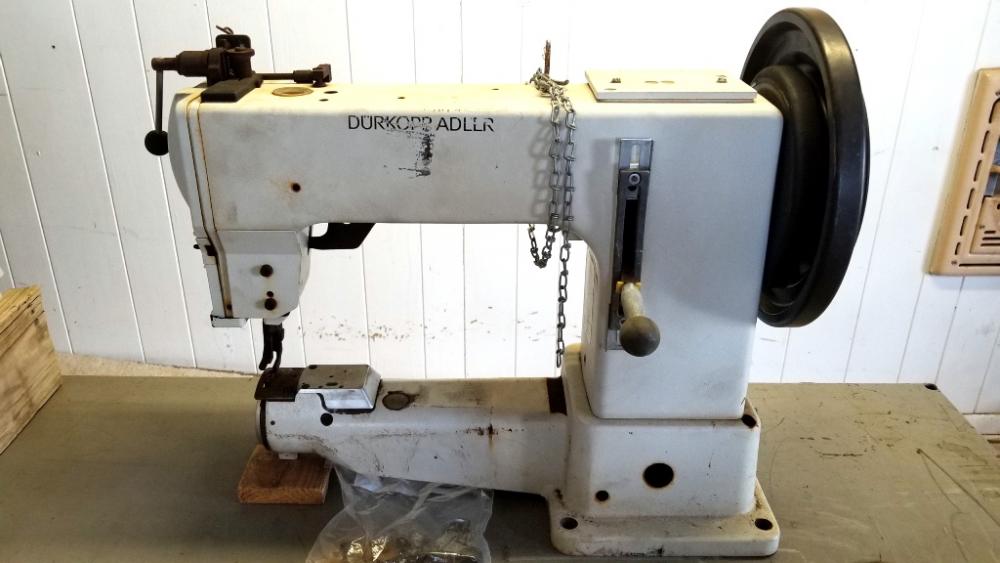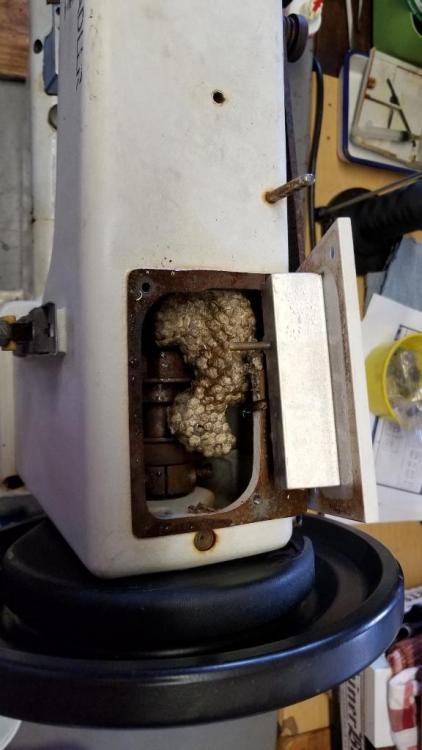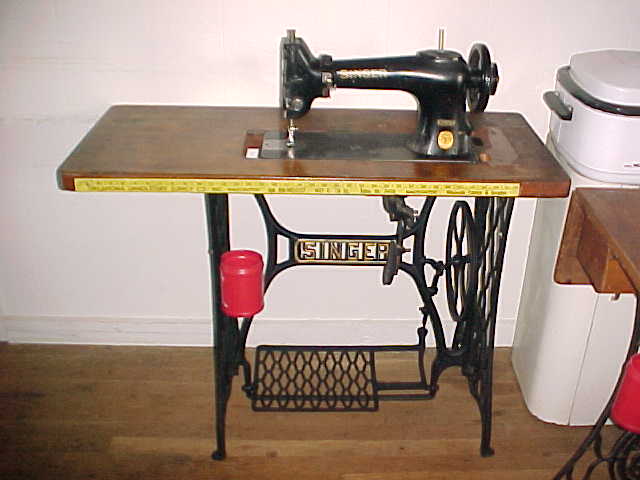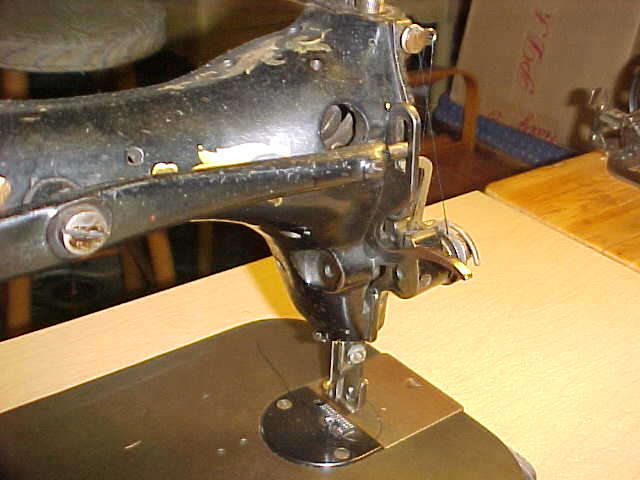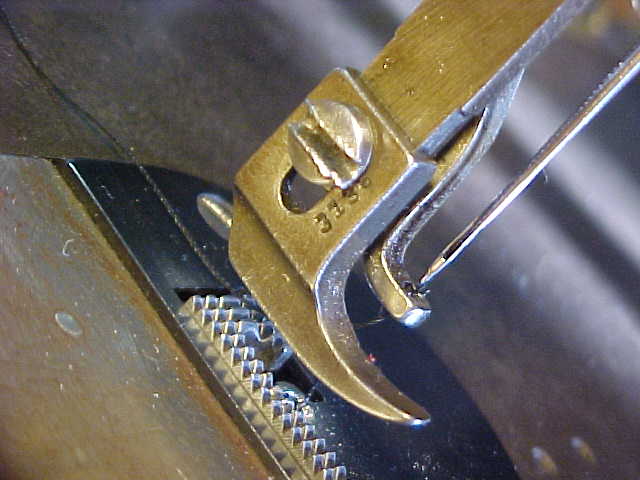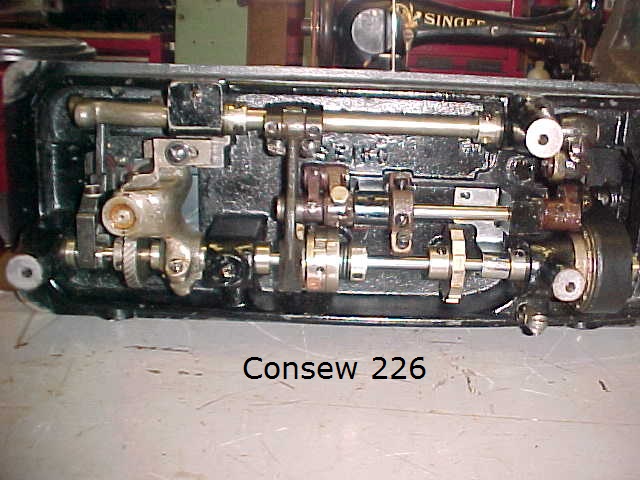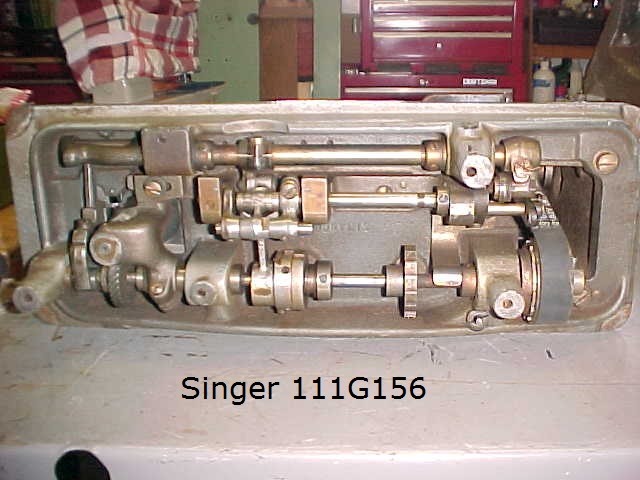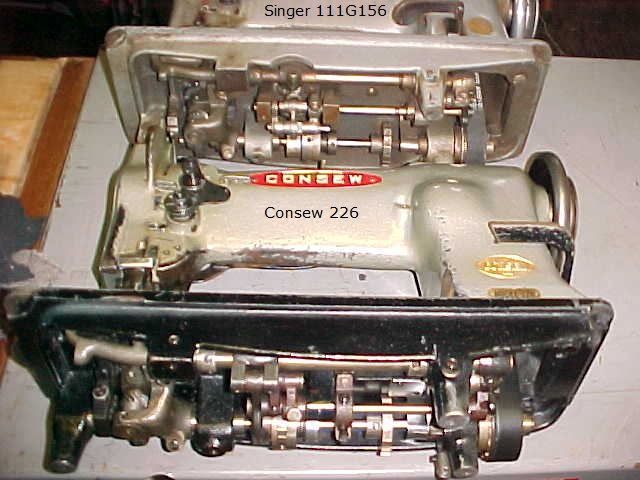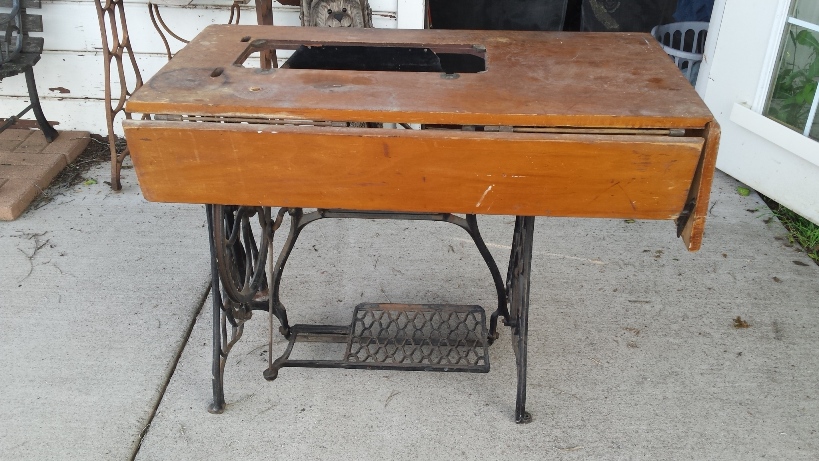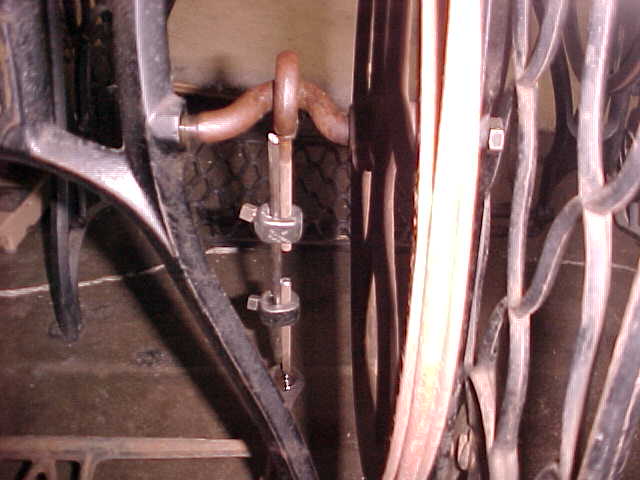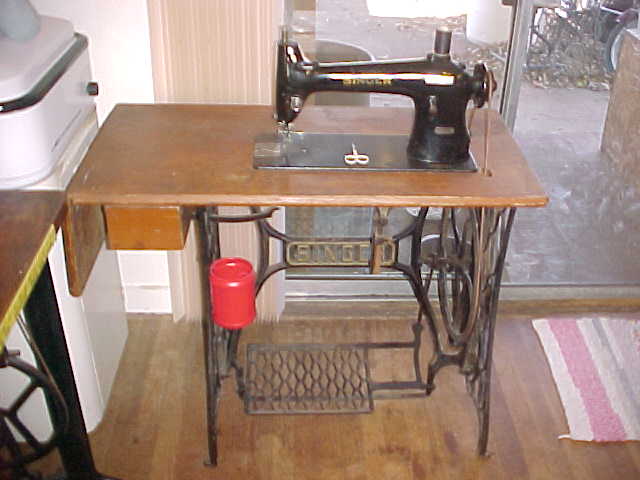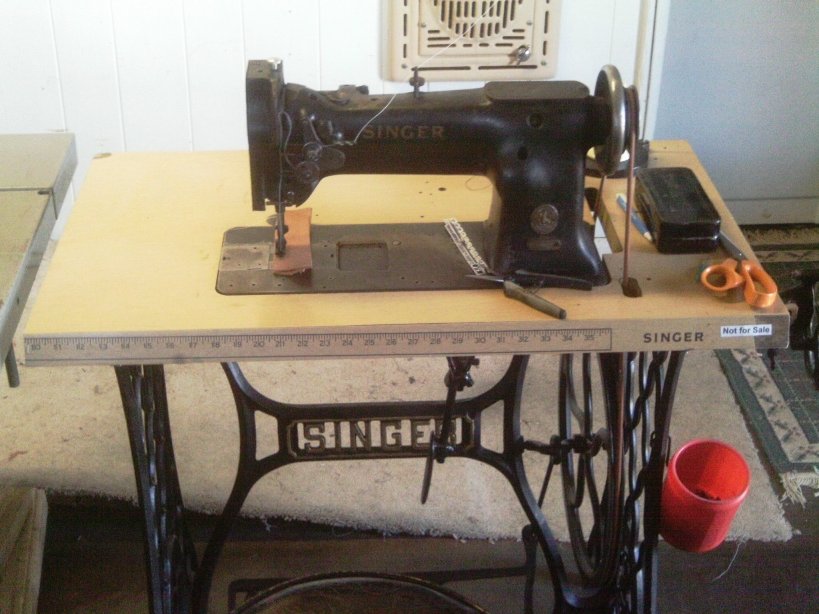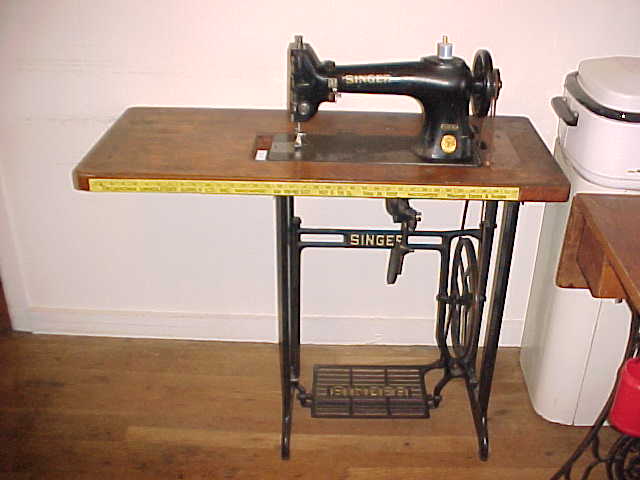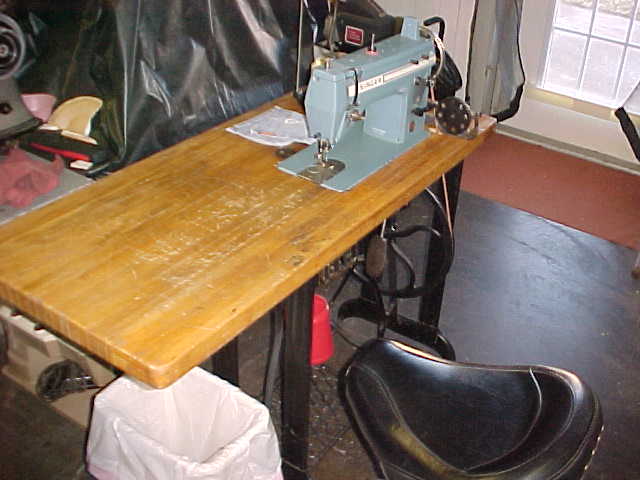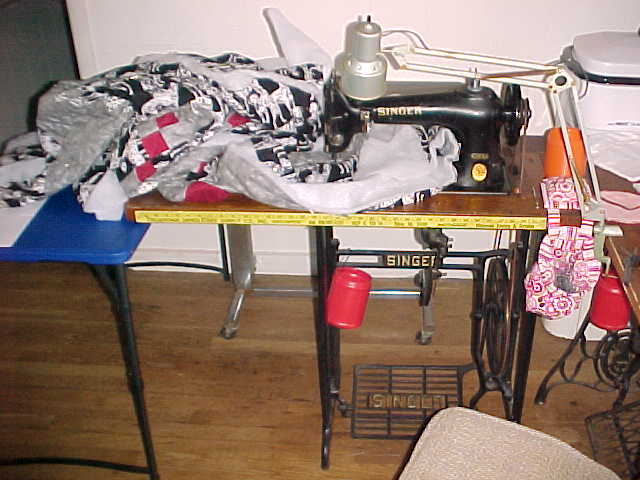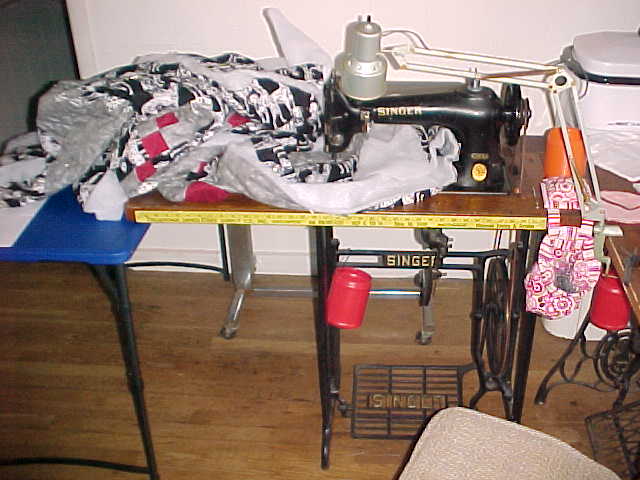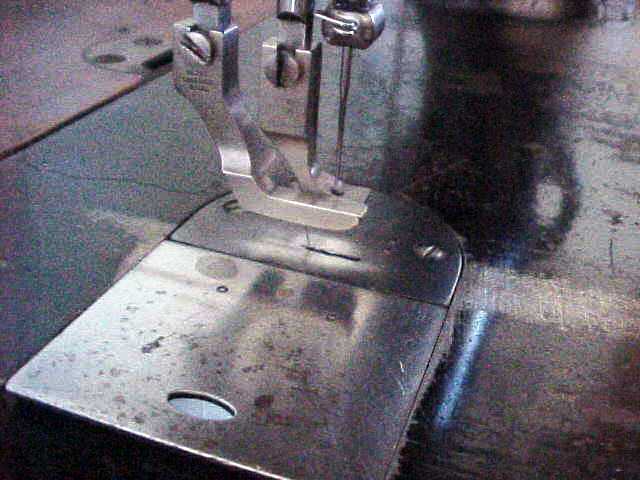-
Posts
483 -
Joined
-
Last visited
Content Type
Profiles
Forums
Events
Blogs
Gallery
Everything posted by cdthayer
-
Singer 31-15: Check to make sure that your needle is oriented with the long groove to the left of the operator toward the face plate of the machine, and that it is threaded from left to right through the needle eye. CD in Oklahoma
-

Rusty Adler 67-73 t w/ ac motor, do or don't?
cdthayer replied to Badem's topic in Leather Sewing Machines
That looks like a good “winter project”. I’d say go for it! Here’s my winter project this year. I started soaking it in oil in September 2018 to get it loosened up. The outer foot presser bar is the only thing still seized. The first thing on the agenda was to evict a hive of yellow hornets. Since then, things haven’t been nearly as exciting.... CD in Oklahoma -
I had not seen the Singer 119-2 machine before. Thank you for showing it. It appears that it would be an excellent machine for mending repairs, where a person would have to get into tight areas. I still don’t have a source for 78-series parts. I still haven’t needed any. I don’t use the machine a lot, but I found out that it’s really useful for basting the lining to the outer shell on insulated work clothing when I need to replace a zipper. The long 3SPI basting stitches are easy to remove afterwards. I swapped the machine into a different treadle since the last photos shown in this thread. It’s now in an industrial-size Singer treadle that is outfitted with a household 12-inch flywheel. I didn’t have a 16-inch flywheel for this treadle, so I put a smaller one in it with an extended pitman rod. It works just fine this way. Besides my basting with it, the wife still uses it for straight-line quilting, so it is still set up for Tex30 thread for both uses. CD in Oklahoma
-
Rant: Billroy1, are you one of those east coast liberals that wants everything for you, and to hell with the rest of us? Why don’t you put some information about yourself in your profile? Your “About Me” says “coming soon”. BS. Put it in there or shut up. I wish that I had checked that before giving you the photos that you wanted. I’ve had it with the radical activists swooping in to turn a good forum into crap. First it was a radical feminist in NY that wanted to take the stage, what is your cause? CD in Oklahoma
-
The pitman rod (and flywheel) is from a domestic-use smaller treadle. I had to make the pitman longer for the larger industrial stand. I’ve since moved the 16-41 to a regular industrial treadle (16” flywheel) to use the Frankenstein treadle (12” flywheel) to run a 78-3 needle-feed machine to do straight-line quilting. The smaller flywheel slows it down a tiny bit, but not much. The outer foot on my machine is part #3136, modified by cutting the right toe off. I don't know what number tension spring mine has. CD in Oklahoma
-
I’ve got my Consew 226 about ready to put into use, except that I can’t figure out how to balance the forward and reverse stitch lengths. This is the older version of the 226, but I’m not sure which one. It’s not an “R” machine. The reverse stitch length is a much shorter length than the forward. Did I miss a thread where this was discussed? The Consew 226 is built differently than the Singer 111G156, so I can’t use the Singer guide. Thanks for any help. CD in Oklahoma
- 7 replies
-
- consew
- stitch length
-
(and 1 more)
Tagged with:
-
That looks like the model that the Army Air Corps used to parachute out of planes to outfit remote encampments during WW2. I wish I had it. CD in Oklahoma
-

"American" big iron machine - anyone ever seen one of these?
cdthayer replied to Cantab91's topic in Leather Sewing Machines
If you look back through the site posts over the years, you’ll notice that there have been several knowledgeable members that were very active on the board answering questions, giving advice, and trying to help resolve leather working problems, that are no longer giving of themselves as much today. Sure, some of them have passed on, or moved off into some other medium, but many of them that are still here and used to be one of the first to come to the aid of a newbie are not posting much any longer. Wiz was still posting, and putting up with the newbie lack of knowledge. The other experts are still here, but they know how some PC poster can flame them at the drop of a hat, like just happened to Wiz. What are the chances that Hippo did not know that the OP had been looking for a machine to sew lamb skin purses in the only 5 posts that she had made when she asked about this machine? And there’s no telling how many PMs that she may have exchanged with Wiz about her business, her purses, her search for the perfect machine, and maybe even a potential business for her husband, or anything else about her purse business. I think that the Hippo poster from the east coast jumped the gun to blast her liberal opinion without researching anything at all. As a member of the fly-over section of this nation, I’m not surprised. I’ve left other forums because of crap like this, and wouldn’t blame Wiz if he did the same. I’m with RockyAussie. If anyone wants to get their panties in a bunch, help yourself. I don’t like this PC crap. CD in Oklahoma -

"American" big iron machine - anyone ever seen one of these?
cdthayer replied to Cantab91's topic in Leather Sewing Machines
You popcorn-eaters think that you're supporting Wiz? He's helped me several times, and I hate to see him go. Has he not ever helped you? Have you ever seen him say something that wasn't true as far as he knew? He said "I'm done with Leatherworker.net for now. It's been a blast. Goodbye." Do you really think that he was joking? CD in Oklahoma -

"American" big iron machine - anyone ever seen one of these?
cdthayer replied to Cantab91's topic in Leather Sewing Machines
The original poster is new here, and she had mentioned in one of her first posts that she was working with lamb skin and “more delicate leathers”, so Wiz’s comment could have been referring to this machine as not being the one for her, but maybe her husband could make use of it to start up a different business. I didn’t see anything in his post about women not being capable. I think that’s a bum rap. CD in Oklahoma -

Commercial Singer Treadle (motorized) w/96-10 Head
cdthayer replied to suzelle's topic in Leather Sewing Machines
You’re welcome for the information. I hope it helps you get going. No, the difference isn’t between a vertical or horizontal positioned bobbin, because they are both positioned the same. It’s that the 96-40 rotary hook goes 360 degrees around the bobbin, while the 31-15 oscillating hook goes around about 180 degrees, and then reverses direction to the starting point. Rotary versus oscillating. And for what it’s worth, a word of caution when talking about vertical and horizontal bobbin sewing machines: In the household-use machine world, machines are sometimes referred to as “vertical bobbin” or “horizontal bobbin”, which are both correct, and the horizontal bobbin is sometimes also called a “drop-in bobbin” type. But in the industrial-use machine world, machines tend to be referred to as having a “vertical shaft” or “horizontal shaft” when talking about the hook and bobbin. One group talks about the actual bobbin, and the other group talks about the shaft that drives the hook around the bobbin, so there can be a little confusion along these lines. As you can see, a machine (either household or industrial) with a vertical shaft will have a horizontally positioned bobbin, and one with a horizontal shaft will have a vertically positioned bobbin. Just a little quirk in the sewing machine terminology. The treadle stand shown in my previous post also has a fold-up extension on the back that can’t be seen in the photo. But, the treadle stand that I use most has a shortened top like you mentioned, but it doesn’t have a folding extension. I just use an auxiliary table or tables at the end and/or behind to create whatever table space is needed for each project. I had my 31-15 in it for a long time, and just recently took it out and put my Singer 16-41 in it. I ran out of room to keep industrial treadles set up and ready to use, so I sidelined my 31-15 for a while. I just love having too many machines, and I’m not ashamed to admit it. I search the internet every day looking for more. The additional photo that you provided confirms that your stand already has been modified to a 2-piece pitman rod, so you may be interested in how I made mine. Thank you once again for your past sewing machine parts purchase. I don’t market parts online anymore since 2015, only in my little brick and mortar sewing shop, but email me again if you think I may have something that you need. CD in Oklahoma -

Commercial Singer Treadle (motorized) w/96-10 Head
cdthayer replied to suzelle's topic in Leather Sewing Machines
Hi suzelle. I have a Singer 96-40, and a Singer 31-15 that I use in treadles. They both fit in the same opening. The 96 is comparable to the 31, with the main difference being that the 96 is a rotary where the 31 isn’t. I’m not sure where you’re going to find the bobbin case position bracket and screw. The 16” flywheel may be tough to find, but you could always put a household 12” flywheel on it until you do. You’ll have to lengthen the pitman rod somehow. It looks like your machine already has a treadle-operation handwheel on it. Mine has a very small solid wheel. I tried mounting the large handwheel from my 31-15 onto my 96-40, but it wouldn’t fit, so you’ll need to try something else if you want to go larger. The 96 takes 16x257 needles, #52237 bobbin case, and #40264 bobbins. I have mine set up as a darning machine for fabric, fitted with a hopping foot and blank needle plate (feed dog removed). CD in Oklahoma -
Looks good. Nice job. CD in Oklahoma
-
That free play may just mean that she’s broke-in good and already well-trained? The bobbins are interesting. CD in Oklahoma
-
Your rig is looking good dikman. You might try learning to treadle with just your right foot. That’s how I operate all of my treadles. My wife is learning to operate her Singer 78-3 needle-feed to do straight-line quilting with just her right foot, and has been having good luck. Of course, she’s just sewing through cotton layers with it, so there’s very little resistance. The ease and smoothness of about any treadle rig will depend upon the material being sewn. I sew mostly wovens and vinyls with my treadles, and they work great for that. Sewing a zipper into a pair of leather shotgun chaps was stiffer-going than sewing zippers into insulated overalls, although still very do-able. During my experimentation, my Singer 111W153 treadled very nicely in my Singer industrial treadle, until I put a couple of pieces of belt-thickness veg-tanned leather under the foot, then I had to push so hard that I was afraid that I was going to break something. The density of the material that you’re driving your needle through will make a big difference to the ease of the operation. The size of the needle will make a difference too, of course. I like the looks of Bruce’s Singer 31-15 household treadle that Lee posted. Thanks Lee. The only treadle rig using an industrial head in a household stand that I have is the 78-3 mentioned above. I have one Singer industrial treadle that has a household flywheel in it that I used for a while to power my Singer 16-41, and liked the way that it operated. For my kind of work, I think that the smaller flywheel is a benefit to slower speed without losing too much power. I ran out of room to have all of my treadles set up, the top on this treadle was not too good, so I switched the 16-41 into a regular Singer industrial treadle stand that used to hold my 31-15 roller foot machine. CD in Oklahoma
-
That’s a really nice-looking way to make a 2-piece pitman rod. It’s a lot nicer than the one that I came up with. Looks good! But, I’m wondering if operating a Singer 211G166 walking foot machine in this stand will put too much stress on the re-welded stub? CD in Oklahoma
-

Zig zag machine for straight stitching ?
cdthayer replied to patria's topic in Leather Sewing Machines
Your stitches may look different between the SS and the ZZ machines. I don’t have any experience with your zigzag machine brand, but I have run into that using a Singer 20U zigzag machine for straight stitching. It’s an older 1960s machine (doesn’t have the second knee-operated cam for varying the zz width) that is equipped with a zz needle plate, zz feed dog, and a zz foot. We tried to use it for hemming jeans using Tex80 jean thread in a size 18 needle, but the stitches underneath all come out slanted. The way that we sew our hems, the underneath stitches are what end up showing to the outside, so we need them to look nice. It was a good excuse for me to substitute a Singer 95-40 straight stitch machine for the jeans hemming, and absconding with the 20U for my treadle zigzag machine for other sewing. It’s interesting that we have a newer 1990s Singer 20U33 zigzag machine at a second location that has been used for jean hems for several years, and they come out great. Besides the ages of the machines, the newer machine came with optional ss needle plate, ss feed dog, and ss foot. The other difference, that may have made the most difference come to think of it, is that we’ve always used a size 20 needle in that newer machine. Anyway, keep in mind that we’re sewing a woven fabric and not a dense material like leather, so our needle holes heal themselves if they’re too big. I don’t know what our stitches would look like in leather, but it seems that even most household zigzag machines have a slight slant to the stitches instead of nice straight stitches that a straight stitch only machine can produce. I don’t think that using a zz machine all of the time for ss will hurt the machine, although the zz mechanism probably won’t work as well if you ever try to use it later. The worst thing for a zz machine is lack of exercise for the zz linkage, and they tend to not respond well after a long period of non-use. I don’t have any experience with a double-needle machine. CD in Oklahoma -
I’m not sure if that treadle/machine unit has ever run. I’m wondering if someone was trying to accumulate parts to come up with a working unit. The flywheel doesn’t appear to have the same paint on it as the rest of the stand, so maybe it’s a replacement from a newer model stand. Getting a replacement foot plate to match your pitman rod would be easy to do here in the states, but I’m not sure about Oz. I’d go that route first before I tried to marry the broken plate to your rod. I can’t see the second belt hole in the table top, but if you sight down through the holes by aligning your eye with the machine balance wheel pulley with the hole in the table, you can get an idea whether the belt went to one of the clutch pulleys or to the flywheel (or neither). If the second hole is a slot, it may not tell you much, but the hole in the front has to line up fairly well with something obvious below for the belt to not rub. That type of clutch would have a small electric motor attached to it on the end opposite the actuation lever. Various motors can be swapped out to attach to the clutch unit. I can’t see if the frame would be in the way or not from the photo. The motor would need to mount outside of the frame. Using a household treadle stand to power an industrial machine works just fine, depending on what you’re sewing. I have my 1950 Singer 78-3 needle-feed machine on a small household tubular steel treadle stand. My wife quilted two quilts on it in the past couple of weeks. CD in Oklahoma ETA: I just remembered that some of the older treadle stands that had wooden pitmans were narrower than the newer models of treadle stands, so finding a plate to fit may be more difficult than I stated.
-
That looks to me like a home-made setup using a household treadle stand to power an industrial machine head. Most Singer industrial treadle stands have a 16” diameter flywheel, while that one has the design of a 12”. What size is it? The clutch assembly (does it say Singer or Atlas on it or something else?) appears to be mounted in reverse of how it would be mounted to power with a motor, so it was probably used only as a speed reducer or increaser depending on how the belts were arranged. The machine head appears to have the smaller electric-type pulley on it, but that would be unusual for a 1923 model. Maybe it just looks small in the photo. Whether or not it is a smaller pulley, the step pulley (clutch assembly) arrangement may have helped make the unit easier to treadle or control. It’s an interesting setup, and I probably would have drug it home too. CD in Oklahoma ETA: I was wrong about the clutch being mounted in reverse. The motor would mount outside of the treadle stand frame, if the frame is not in the way. The clutch could have been mounted onto an old H-leg power stand at one time. That's where I see most of them.
-

I know this "leather" sewing machine forum....but
cdthayer replied to mixmkr's topic in Leather Sewing Machines
Most of my work is doing repairs, but I did plan, cut, and sew one new Bimini Top out of Sunbrella and Vinyl Laminate (T92 thread) using my Consew 225. Otherwise, I’ve resewn the existing hems and seams on boat covers, awnings, and truck tarps with the 225. I usually rolled the machine out onto the sidewalk in front of the shop or into the alley beside the shop to do it, so I got some good advertisement out of those repairs. Nothing like a guy sewing outside on a big project to catch people’s attention. With my limited experience on marine sewing, bouncing questions off of me probably won’t get you much. I used my Singer 111W153 to resew all of the webbing on a large mesh swimming pool cover one time. Wow, that was a job! That thing was heavy! I spent most of my time folding, lifting, and refolding it to get it under my needle. Also with my Consew 225, I’ve sewn new marine vinyl for small projects such as tractor seats and what-not, but just did the sewing to someone else’s specifications on the pieces that they had cut. I did plan, cut, and sew some new vinyl covers for the head/face portion of some chiropractor’s adjustment benches out of his vinyl. That helped me learn how to sew tight curves. CD in Oklahoma -
Wow. You’re getting a fleet of 78s aren’t you. Now you just need the 78-2 with the bobbed-off bed next to the needle. I think one of those would be real handy for making repairs. I haven’t tried to find any feet for my 78-3. The #37854 hook is available new from my distributor for the Consew Class 28 and Singer Class 78 machines, so you can probably get it about anywhere. Yes, that’s a tiny little lube pot. It has a wire spring that snaps down on the thread to make sure it rides against the felt pad. I don’t know what the little tab under the needle plate is for. CD in Oklahoma
-
Singer 78-3 - The Ma & Pa Machine If you’re wanting to get a good needle-feed machine for your light leatherwork, but are having trouble getting financing from the one that holds the purse strings (wife), you might consider going for a Singer 78-3. But, make sure that you call it a “quilting machine”, because it is an excellent straight-line quilting machine. That may help get one into your herd of machines. My wife tried mine and liked it so well that she quilted two quilts in four days, her first treadle quilting ever. Yea, she had some sore muscles when she was done. I set it up for her with a size 14 needle (135x17-14), set the tensions for Tex30 polyester/cotton thread, and set the stitch length to about 12 stitches per inch. It didn’t miss a stitch, and she didn’t get any puckers at the end of a stitch line. She was impressed, and is looking forward to doing more quilts on it. On the other hand, I had initially tested it on vinyl set up with a size 18 needle, using Tex90 thread, the stitch length set to 4 SPI, and it sewed great. I understand that it will handle up to size Tex138 thread, and sew up to 3/16” thick. It’s not designed as a harness machine, but it will work well for lighter projects. My 1950 model came to me with a #36280 serrated inner foot and a #36281 smooth outer 3/16” welting foot. There are no feed dogs, so there are no marks underneath. My inner foot doesn’t have sharp teeth. I don’t know if that’s wear from use, or if someone worked it over to dull them. With the presser foot pressure set at about half of the thumbscrew adjustment, foot marks on textured vinyl are negligent but noticeable on smooth vinyl. If I did much smooth vinyl or leather with it, I’d probably try dipping the foot to smooth it out. When it comes to a “his and hers” craft sewing machine, the 78-3 is about as dual-purpose as I could ask for. CD in Oklahoma
-
The insurance policy for my little shop came a few days ago, and I always skim through stuff like that while I’m on my throne in the mornings. I noticed that I now have a new “Endorsement” on my policy called “Actual Cash Value”. It essentially means that from now on, when calculating benefits for replacement of any covered damage, the damage will be reduced for depreciation for such “considerations as age, condition, reduction in useful life, obsolescence, and any pre-loss damage including wear, tear, or deterioration”. My building is one of the oldest downtown buildings that were built when our town was established. I’m not exactly sure when that was, but the words “age”, “obsolescence”, “wear”, and “tear” will probably apply to all of the old downtown buildings, including mine. I had to chuckle about the page or two ahead of this new endorsement page that still had the normal chit-chat about as the purchaser of the insurance I should always consider the replacement cost when selecting coverage, and have the ability to determine the amount of coverage that I want to purchase. Yea, sure. It sounds to me like I just became uninsured even though I pay for insurance...... CD in Oklahoma
-
That picture is kind of an interesting way of looking at things....... CD in Oklahoma
-
My 1944 Singer 111W153 has a safety clutch, but I don’t know in what order the 111-series of machines were introduced, and I have no idea if a safety clutch could have been retro-fitted after the machine came out. CD in Oklahoma



